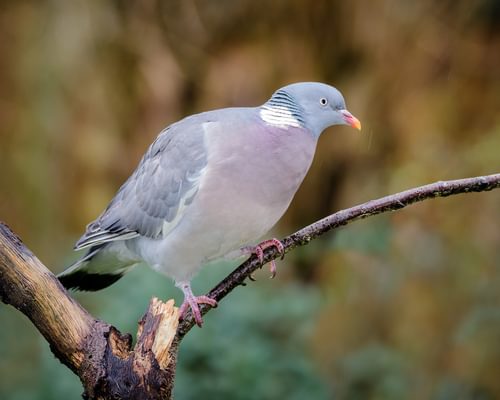Hidden in plain sight: the secret differences between male and female Wood Pigeons that most UK birdwatchers miss. While these ubiquitous garden birds might appear identical at first glance, several subtle yet reliable features can help you distinguish between the sexes.
Key Visual Differences
The most noticeable difference lies in the neck region. Male Wood Pigeons display more extensive and vibrant iridescent patches on the sides of their necks, flashing brilliant greens and purples when caught in good light. Females possess these same patches, but they appear smaller and less vibrant, with a more subdued sheen that doesn't catch the light as dramatically.
Another reliable indicator is the white neck patch or "collar" present in both sexes. In males, this patch appears bright white and more clearly defined, while females typically show a slightly duller or occasionally cream-tinged patch. This difference becomes particularly evident when observing a pair side by side on a garden feeder or branch.
Size can also help with identification, though this requires a direct comparison. Males are typically 5-10% larger than females, with a marginally bulkier build and slightly larger head. When a pair is perched together, this size difference becomes more apparent, with the male often adopting a more upright posture.

Female Wood Pigeon sat on her eggs in the nest
Behavioural Clues
Behaviour provides additional identification hints, particularly during the breeding season (April through September in the UK). Males perform distinctive courtship displays, including dramatic flight patterns where they climb steeply before clapping their wings and gliding down in a circular pattern.
During courtship, males also noticeably puff out their chest and neck feathers, making their iridescent patches appear even larger and more impressive.
At feeding stations, males typically exhibit more assertive behaviour, often standing more upright with puffed-out chest feathers. They may occasionally bob their heads toward females in a characteristic display. Females, by contrast, can appear slightly more wary at feeding sites, spending more time scanning for potential threats.
During nest-building, females take the lead in gathering materials, while males focus more on territory defence. If you observe a Wood Pigeon collecting twigs or other nesting materials, it's more likely to be a female, though both parents share incubation duties once eggs are laid.

Identification of male and female wood pigeons by just looking at them alone is pretty hard
Seasonal Considerations
Identifying the sexes becomes somewhat easier during spring and summer breeding seasons when differences in both appearance and behaviour are most pronounced. Males' neck iridescence appears enhanced during this period, and their courtship behaviours provide clear indications of sex.
Winter presents more challenges for identification as both sexes' plumage becomes marginally duller, and courtship behaviours cease. During these months, focusing on the extent of neck iridescence and the brightness of the white collar remain your most reliable visual cues.

A pair of wood pigeons foraging for food on the ground
Common Identification Challenges
Even experienced birdwatchers sometimes struggle with Wood Pigeon sex identification, particularly in poor lighting conditions when iridescence is difficult to observe. Young birds add another layer of complexity, as juveniles of both sexes appear duller overall until they develop adult plumage.
Light conditions significantly affect identification success—bright, direct sunlight makes the iridescent differences between males and females most apparent. On overcast days, focus more on size differences and behavioural cues to make accurate identifications.

A female wood pigeon sat on the nest
Practical Observation Tips
For the best chance of distinguishing between male and female Wood Pigeons, observe pairs rather than solitary birds whenever possible. Garden feeding stations provide excellent opportunities for comparison when pairs feed together.
Binoculars help tremendously with spotting the subtle differences in neck iridescence and white collar brightness. Position yourself so the birds are illuminated from the front or side, which makes iridescent colours most visible.
Patience yields results—spend time watching Wood Pigeons in various settings and light conditions to develop your identification skills. With practice, the subtle differences between males and females become increasingly apparent, turning what might initially seem like identical birds into distinctly recognisable individuals.
Understanding these differences not only enhances your birdwatching experience but also provides insight into the breeding biology and social structure of one of Britain's most successful and adaptable bird species.

Wood Pigeon preening its feathers

